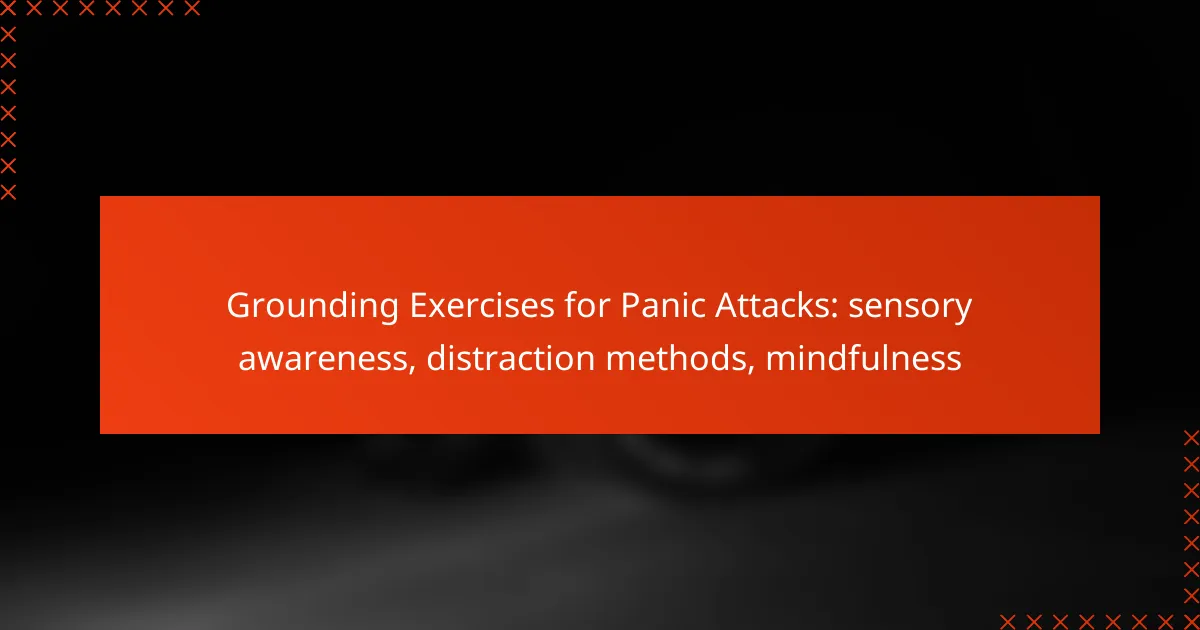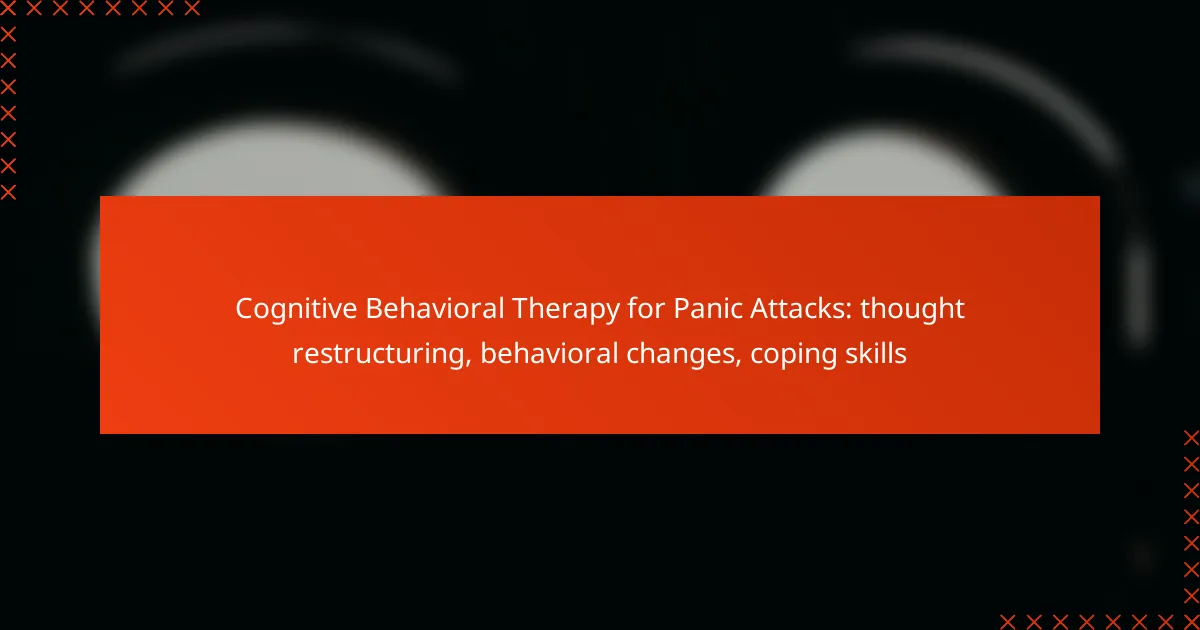Grounding exercises are powerful tools for managing panic attacks by helping individuals redirect their focus from overwhelming emotions to the present moment. Techniques such as sensory awareness, distraction methods, and mindfulness practices can significantly alleviate anxiety symptoms and foster a sense of control and calm.
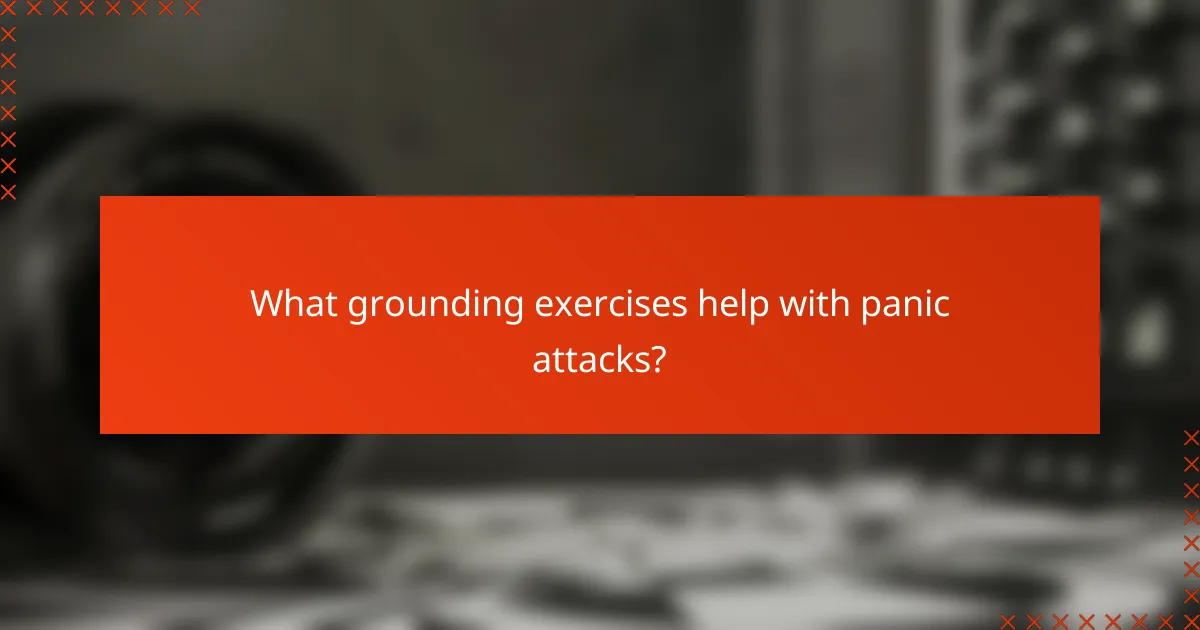
What grounding exercises help with panic attacks?
Grounding exercises can effectively alleviate panic attacks by redirecting focus away from overwhelming feelings and towards the present moment. Techniques such as sensory awareness, distraction methods, and mindfulness practices are particularly useful in managing anxiety symptoms.
5-4-3-2-1 sensory technique
The 5-4-3-2-1 sensory technique helps ground you by engaging your senses. Identify five things you can see, four things you can touch, three things you can hear, two things you can smell, and one thing you can taste. This method shifts your attention from panic to your immediate environment.
To practice, take your time with each sense, allowing yourself to fully experience each item. For example, when focusing on touch, you might run your fingers over a textured surface or feel the weight of your body against a chair.
Breathing exercises
Breathing exercises are essential for calming the nervous system during a panic attack. Techniques like deep breathing or the 4-7-8 method can help slow your heart rate and reduce anxiety. Inhale deeply for four seconds, hold for seven seconds, and exhale slowly for eight seconds.
Practice these exercises in a quiet space where you feel safe. Aim for several minutes of focused breathing to help regain control over your body’s response to panic.
Body scan meditation
Body scan meditation involves mentally scanning your body for tension or discomfort, promoting relaxation and awareness. Start at your toes and gradually move up to your head, noticing any sensations without judgment. This practice can help you reconnect with your body and reduce feelings of panic.
Set aside about 10-20 minutes for this meditation. Find a comfortable position, close your eyes, and breathe deeply as you focus on each body part, releasing tension as you go.
Progressive muscle relaxation
Progressive muscle relaxation (PMR) is a technique that involves tensing and then relaxing different muscle groups. This method helps identify physical tension associated with anxiety and promotes overall relaxation. Start with your feet, tense the muscles for a few seconds, then release and notice the difference.
Continue this process through your legs, abdomen, arms, and face. Practicing PMR for about 15-30 minutes can significantly reduce anxiety levels and help you feel more grounded.
Mindful observation
Mindful observation encourages you to focus intently on an object or your surroundings, fostering a sense of calm. Choose an item, such as a plant or a piece of art, and observe it closely, noting details like color, texture, and shape. This practice can help distract your mind from panic and center your thoughts.
Spend at least five minutes in this observation, allowing your mind to engage fully with the experience. This technique can be particularly effective in environments that feel safe and comfortable.
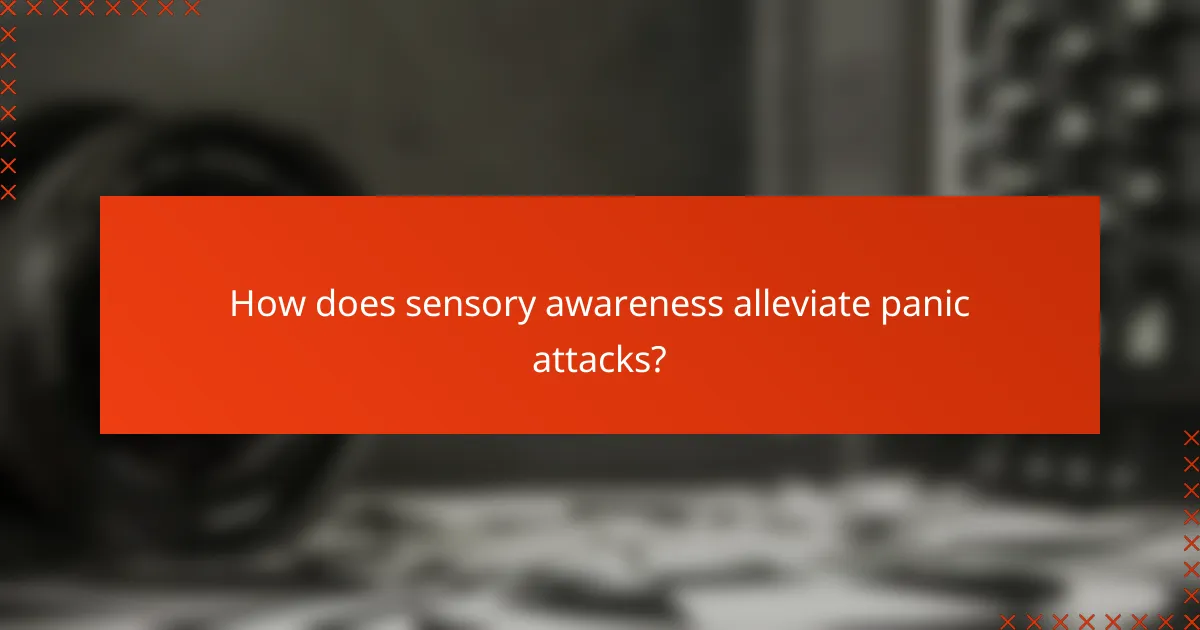
How does sensory awareness alleviate panic attacks?
Sensory awareness helps alleviate panic attacks by grounding individuals in the present moment, reducing feelings of overwhelm. By focusing on tangible sensations, people can divert their attention from anxiety and regain a sense of control.
Engaging the senses
Engaging the senses involves actively noticing what you can see, hear, smell, taste, and touch. For example, during a panic attack, you might focus on the texture of an object in your hand or the sounds in your environment. This practice can help redirect your thoughts away from panic and towards the present.
To effectively engage your senses, try the “5-4-3-2-1” technique: identify 5 things you can see, 4 things you can touch, 3 things you can hear, 2 things you can smell, and 1 thing you can taste. This structured approach can enhance your sensory awareness and promote calmness.
Shifting focus from anxiety
Shifting focus from anxiety involves redirecting your attention to something other than your worries. This can be achieved through activities like counting backward from 100 or reciting a favorite poem. Such distractions can break the cycle of anxious thoughts and provide temporary relief.
Consider using physical activities, such as squeezing a stress ball or walking in nature, to shift your focus. These actions not only distract your mind but also engage your body, promoting relaxation and reducing panic symptoms.
Enhancing present-moment awareness
Enhancing present-moment awareness means cultivating a mindful state where you acknowledge your thoughts and feelings without judgment. Practicing mindfulness techniques, such as deep breathing or meditation, can help you stay anchored in the present, mitigating panic attacks.
Incorporate mindfulness into your daily routine by setting aside a few minutes each day for focused breathing or guided meditation. Apps and online resources can provide structured sessions to help you develop this skill over time, making it easier to access during moments of panic.
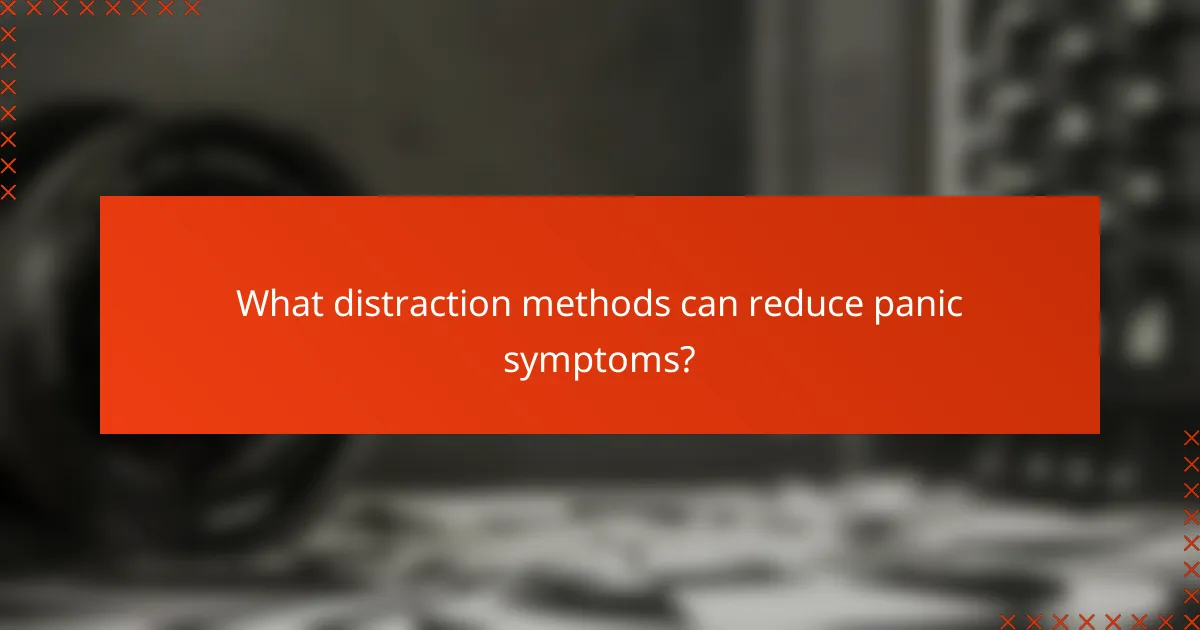
What distraction methods can reduce panic symptoms?
Distraction methods can effectively reduce panic symptoms by redirecting focus away from anxiety triggers. These techniques engage the mind and senses, helping to ground individuals in the present moment.
Counting objects in the environment
Counting objects in your surroundings is a simple yet effective distraction method. By focusing on specific items, such as the number of chairs in a room or the colors of cars passing by, you can shift your attention from panic symptoms to a tangible task.
To use this technique, start by selecting a category, like colors or shapes, and count how many you see. This can be done silently in your mind or aloud, depending on your comfort level. Aim to count at least five items to fully engage your focus.
Listening to calming music
Listening to calming music can significantly alleviate feelings of panic. Music with a slow tempo and soothing melodies can help lower heart rates and promote relaxation, making it easier to manage anxiety symptoms.
Consider creating a playlist of your favorite calming tracks or exploring genres like classical, ambient, or nature sounds. Aim for music that you find personally soothing, and keep your playlist accessible for moments when you feel overwhelmed.
Using fidget tools
Fidget tools can provide a physical outlet for anxiety, helping to distract the mind during panic attacks. Items like stress balls, fidget spinners, or textured objects can engage your hands and redirect nervous energy.
When selecting a fidget tool, choose one that feels comfortable and satisfying to use. Keep it within reach, so you can easily access it during stressful moments. Remember to focus on the sensations of the tool, such as its texture or weight, to enhance the grounding effect.

What mindfulness techniques are effective for panic attacks?
Mindfulness techniques can significantly alleviate panic attacks by promoting awareness and grounding in the present moment. Effective methods include mindful breathing, guided imagery, and journaling thoughts and feelings, each offering unique benefits for managing anxiety and stress.
Mindful breathing
Mindful breathing focuses on the breath to anchor attention and reduce panic symptoms. To practice, find a quiet space, close your eyes, and take slow, deep breaths, counting to four as you inhale and exhale. Aim for a few minutes of this practice, gradually increasing the duration as you become more comfortable.
Common pitfalls include rushing the breath or allowing distractions to take over. Instead, gently redirect your focus back to your breath whenever your mind wanders. This technique can be practiced anywhere, making it a versatile tool for immediate relief.
Guided imagery
Guided imagery involves visualizing calming scenes or experiences to shift focus away from panic. This technique can be enhanced by listening to recordings or scripts that lead you through peaceful landscapes or comforting scenarios. Aim to engage all your senses, imagining the sights, sounds, and smells of your chosen imagery.
To maximize effectiveness, practice this technique regularly, even when not feeling anxious. This builds familiarity and makes it easier to access during a panic attack. Avoid overly complex images; simple, serene visuals often work best.
Journaling thoughts and feelings
Journaling helps process emotions and thoughts associated with panic attacks, providing clarity and insight. Set aside time each day to write about your feelings, triggers, and coping strategies. This practice can reveal patterns and help identify specific stressors.
When journaling, focus on honesty and detail, allowing yourself to express whatever comes to mind. Consider using prompts like “What triggered my panic today?” or “What helped me feel better?” This reflective practice can enhance self-awareness and emotional regulation over time.
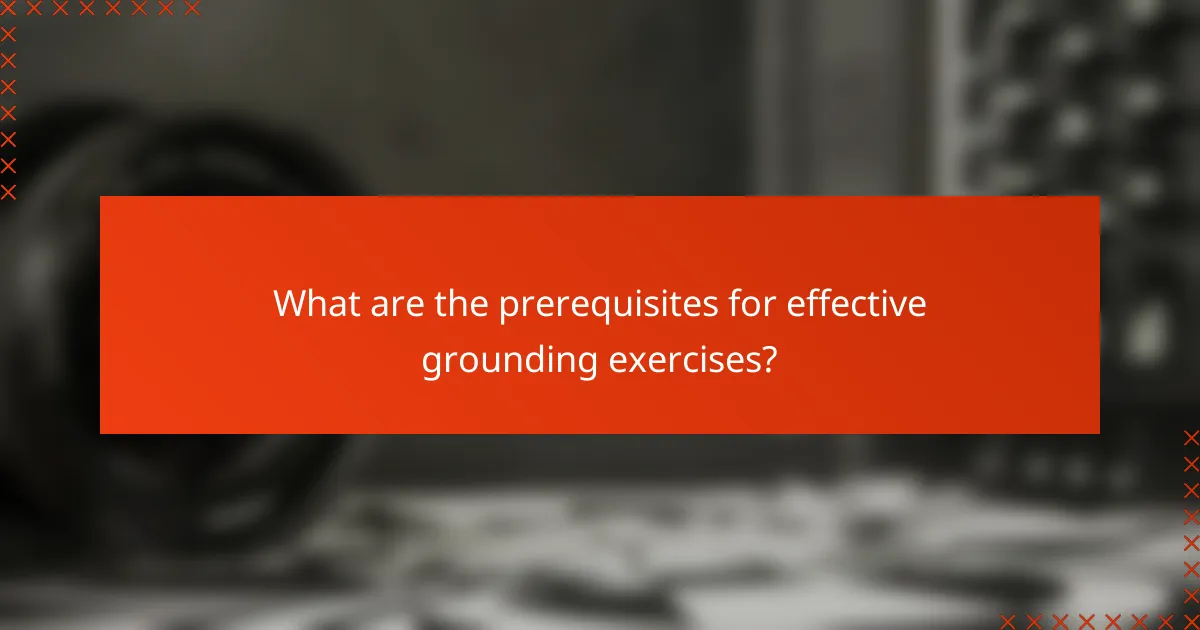
What are the prerequisites for effective grounding exercises?
Effective grounding exercises require a calm environment and a willingness to engage with your senses. Understanding your triggers and having a plan can enhance their effectiveness during panic attacks.
Sensory Awareness
Sensory awareness involves focusing on the present moment through your five senses: sight, sound, touch, taste, and smell. This technique can help redirect your attention away from panic and toward your immediate surroundings. For example, you might notice the colors of objects around you or the texture of a fabric.
To practice sensory awareness, take a few moments to identify and describe what you see, hear, and feel. Engaging with your senses can ground you in reality and reduce feelings of anxiety. Aim to spend a few minutes on each sense to fully immerse yourself.
Distraction Methods
Distraction methods are techniques that divert your mind from panic symptoms to more neutral or positive thoughts. Activities such as counting backwards, naming animals, or reciting a favorite poem can serve as effective distractions. The goal is to shift your focus away from distressing feelings.
Consider creating a list of distraction techniques that work for you, such as listening to music, watching a funny video, or engaging in a hobby. Having this list handy can help you quickly access these methods during a panic attack.
Mindfulness
Mindfulness is the practice of being fully present and engaged in the moment without judgment. It can help you observe your thoughts and feelings without becoming overwhelmed by them. Techniques like deep breathing or guided imagery can enhance mindfulness during a panic episode.
To incorporate mindfulness, set aside a few minutes daily to practice meditation or deep breathing exercises. Apps and online resources can provide guided sessions to help you get started. Regular practice can improve your ability to manage panic attacks when they occur.
